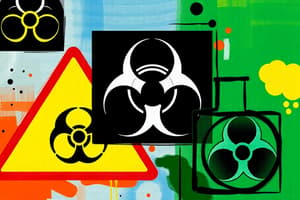Podcast
Questions and Answers
What does OSHA stand for?
What does OSHA stand for?
- Occupational Safety and Health Administration (correct)
- Occupational Standards and Health Agency
- Occupational Safety and Health Association
- Office of Safety and Health Administration
You should look for the name of the chemical, how to handle it, how to avoid dangerous situations, and _____ information on a chemical bottle.
You should look for the name of the chemical, how to handle it, how to avoid dangerous situations, and _____ information on a chemical bottle.
First Aid
Which of the following is NOT a hazard health sign?
Which of the following is NOT a hazard health sign?
- Respiratory Sensitizer
- Oxidizers
- Flammables (correct)
- Carcinogen
What does the Flame Sign indicate?
What does the Flame Sign indicate?
The Gas Cylinder Sign indicates gases under pressure.
The Gas Cylinder Sign indicates gases under pressure.
What do the Target Organs refer to?
What do the Target Organs refer to?
What is a Permissible Exposure Limit (PEL)?
What is a Permissible Exposure Limit (PEL)?
Match the following sections of the SDS to their descriptions:
Match the following sections of the SDS to their descriptions:
Which virus is NOT a common bloodborne pathogen?
Which virus is NOT a common bloodborne pathogen?
What do Universal Precautions state?
What do Universal Precautions state?
List the types of First Aid Kit.
List the types of First Aid Kit.
Eyewash stations must be installed within 10 seconds walking distance from hazard areas.
Eyewash stations must be installed within 10 seconds walking distance from hazard areas.
What should you do if you encounter a victim who is unconscious?
What should you do if you encounter a victim who is unconscious?
Flashcards are hidden until you start studying
Study Notes
OSHA
- Occupational Safety and Health Administration, responsible for ensuring safe working conditions.
Chemical Safety
- Essential information on chemical bottles includes the chemical name, handling instructions, hazard avoidance measures, and first aid information.
Hazard Health Signs
- Carcinogenic, mutagenicity, reproductive toxicity, respiratory sensitizer, target organ toxicity, aspiration toxicity are key health hazards.
Flame Safety Sign
- Identifies substances that are flammable, pyrophoric, self-heating, emit flammable gas, self-reactive, or are organic peroxides.
Exclamation Mark Sign
- Indicates irritants (skin/eye), skin sensitizers, acute toxicity, narcotic effects, respiratory irritants, and hazards to the ozone layer.
Gas Cylinder Sign
- Refers to gases under pressure, requiring careful handling.
Corrosion Sign
- Warns of potential skin corrosion, eye damage, and corrosive effects on metals.
Exploding Bomb Sign
- Signifies explosives, self-reactives, and organic peroxides, marking high risk.
Flame Over Circle Sign
- Denotes oxidizers that can enhance the flammability of other materials.
Environment Sign
- Indicates aquatic toxicity, highlighting environmental hazards.
Skull and Crossbones Sign
- Represents acute toxicity that can be fatal.
Acute vs. Chronic Effects
- Acute toxicity is harmful after a single exposure; chronic effects arise from repeated or prolonged exposure.
Route of Entry
- Describes how chemicals enter the body: inhalation, ingestion, or skin absorption, influencing required personal protective equipment (PPE).
Local vs. Systemic Reaction
- Local reactions occur at exposure sites, while systemic reactions affect the entire body through the bloodstream.
Target Organs
- Organs susceptible to systemic chemical reactions include the liver, heart, lungs, and kidneys.
Permissible Exposure Limit (PEL)
- Sets the maximum average exposure to a chemical over an 8-hour work period.
Threshold Limit Values (TLV)
- Occupational exposure limits established by the ACGIH, indicating safe exposure levels without adverse health effects.
Compatibility
- Safety Data Sheets (SDS) detail chemicals that should not be mixed, ensuring safe handling.
SDS Overview
- Sections 1-4 include identification, hazard identification, composition, and first-aid measures.
- Sections 5-8 cover fire-fighting measures, accidental release measures, handling and storage, and PPE.
- Sections 9-12 provide physical properties, stability, and toxicity information.
- Sections 13-16 address disposal considerations, transport, regulatory information, and additional details.
Chemical Handling Precautions
- Prohibit eating, drinking, or smoking near chemicals. Maintain ventilation, use appropriate PPE, and report any health issues immediately.
Bloodborne Pathogens
- Common pathogens include Hepatitis B, Hepatitis C, and HIV, found in blood and certain body fluids.
Universal Precautions
- Assumes all blood and body fluids are infectious, emphasizing protective measures during exposure.
Reducing Exposure Risk
- Utilize PPE, clean and disinfect surfaces, dispose of waste properly, and follow up on exposure incidents.
Personal Protective Equipment (PPE)
- Includes covering wounds, wearing gloves, safety glasses, and disinfecting contaminated items; PPE must be worn during cleanup.
Cleaning Surfaces
- Cleaning involves removing dirt and germs using soap and water; disinfection follows to eliminate potential infections.
Handling Contaminated Materials
- Dispose of contaminated items carefully while wearing PPE; tools must be cleaned using disinfectants.
First Aid Kit Types
- Type I is fixed; Type II is portable; Type III is for indoor/outdoor use; Type IV is durable for outdoor and rough conditions.
Eyewash Station Guidelines
- OSHA mandates eyewash stations near corrosive materials, while ANSI requires stations within 10 seconds distance with enough water for 15 minutes.
Eyewash Station Types
- Include plumbed stations, mixed concentrate units, and cartridge units for immediate access.
Emergency First Aid Response
- Call 911 if an accident occurs, ensure safety before assisting victims, and avoid moving victims unless necessary.
Checking a Victim
- Ensure consciousness, open airway, breathing, heartbeat, and absence of severe bleeding.
Care for Unconscious Victim
- Dial 911, roll the victim face-up, clear the airway, check for breathing, and scan for severe bleeding.
Eye-Injury Response
- For chemical splashes, avoid squeezing eyes shut, reach an eyewash station immediately, and rinse for at least 15 minutes while holding eyelids open.
Studying That Suits You
Use AI to generate personalized quizzes and flashcards to suit your learning preferences.




